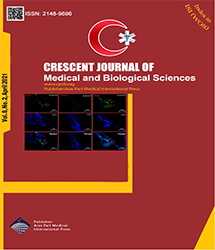
| Original Article | |
| The Therapeutic Effects of Muscle Energy Technique on Sacroiliac Dysfunction in Young Women | |
| Ashraf Vaseghnia1, Azadeh Shadmehr1, Behrouz Attarbashi Moghadam1, Gholamreza Olyaei1, Mohammad Reza Hadian1, Zahra Khazaeipour2 | |
| 1Department of Physical Therapy, School of Rehabilitation, Tehran University of Medical Sciences, Tehran, Iran 2Brain and Spinal Cord Injury Research Center, Neuroscience Institute, Tehran University of Medical Sciences, Tehran, Iran |
|
|
CJMB 2021; 8: 127-133 Viewed : 3312 times Downloaded : 5566 times. Keywords : Muscle energy technique, Sacroiliac dysfunctions, ant innominate, Posterior innominate |
|
| Full Text(PDF) | Related Articles | |
| Abstract | |
Objectives: Muscle energy technique (MET) is one of the alternatives for the treatment of joint dysfunctions. Previous studies investigated this technique without considering the kind of dysfunctions. Therefore, the aim of this study was to evaluate the therapeutic effects of MET by considering the type of dysfunction and the direction of the corrective maneuver in women with iliosacral joint dysfunctions. Materials and Methods: This randomized controlled clinical trial included 60 women with anterior innominate or posterior innominate dysfunctions and were randomly divided into the treatment group (n = 30) receiving a session of MET and the control group (n = 30). The range of flexion and extension of the lumbar, visual analogue scale (VAS), active straight leg raising (ASLR), and pressure pain threshold (PPT) at five points were measured before, after, and 24 hours after MET. Results: Before, after, and 24 hours after the intervention, the mean change of the range of lumbar flexion and extension showed an increase. However, the mean change of the level of VAS and ASLR decreased significantly (P < 0.05) in the treatment group with corresponding 95% confidence intervals. Conclusions: According to the results of this study, using MET by considering the kind of dysfunction may more efficiently improve a patient"s symptoms. |
Cite By, Google Scholar
Google Scholar
PubMed
Online Submission System
 CJMB ENDNOTE ® Style
CJMB ENDNOTE ® Style
 Tutorials
Tutorials
 Publication Charge
Medical and Biological Research Center
About Journal
Publication Charge
Medical and Biological Research Center
About Journal
Aras Part Medical International Press Editor-in-Chief
Arash Khaki
Deputy Editor
Zafer Akan


















